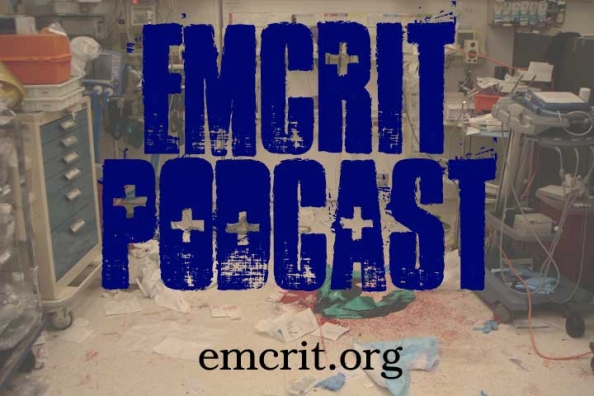
Petition to retire the surviving sepsis campaign guidelines
We need a paradigm shift in the way we develop guidance and treat our sepsis patients
Friends,
Concern regarding the Surviving Sepsis Campaign (SSC) guidelines dates back to their inception. Guideline development was sponsored by Eli Lilly and Edwards Life Sciences as part of a commercial marketing campaign (1). Throughout its history, the SSC has a track record of conflicts of interest, making strong recommendations based on weak evidence, and being poorly responsive to new evidence (2-6).
The original backbone of the guidelines was a single-center trial by Rivers defining a protocol for early goal-directed therapy (7). Even after key elements of the Rivers protocol were disproven, the SSC continued to recommend them. For example, SSC continued to recommend the use of central venous pressure and mixed venous oxygen saturation after the emergence of evidence that they were nonbeneficial (including the PROCESS and ARISE trials). These interventions eventually fell out of favor, despite the slow response of SSC that delayed knowledge translation.
SSC has been sponsored by Eli Lilly, manufacturer of Activated Protein C. The guidelines continued recommending Activated Protein C until it was pulled from international markets in 2011. For example, the 2008 Guidelines recommended this, despite ongoing controversy and the emergence of neutral trials at that time (8,9). Notably, 11 of 24 guideline authors had financial conflicts of interest with Eli Lilly (10).
The Infectious Disease Society of America (IDSA) refused to endorse the SSC because of a suboptimal rating system and industry sponsorship (1). The IDSA has enormous experience in treating infection and creating guidelines. Septic patients deserve a set of guidelines that meet the IDSA standards.
Guidelines should summarize evidence and provide recommendations to clinicians. Unfortunately, the SSC doesn’t seem to trust clinicians to exercise judgement. The guidelines infantilize clinicians by prescribing a rigid set of bundles which mandate specific interventions within fixed time frames (example above)(10). These recommendations are mostly arbitrary and unsupported by evidence (11,12). Nonetheless, they have been adopted by the Centers for Medicare & Medicaid Services as a core measure (SEP-1). This pressures physicians to administer treatments despite their best medical judgment (e.g. fluid bolus for a patient with clinically obvious volume overload).
We have attempted to discuss these issues with the SSC in a variety of forums, ranging from personal communications to formal publications (13-15). We have tried to illuminate deficiencies in the SSC bundles and the consequent SEP-1 core measures. Our arguments have fallen on deaf ears.
We have waited patiently for years in hopes that the guidelines would improve, but they have not. The 2018 SSC update is actually worse than prior guidelines, requiring the initiation of antibiotics and 30 cc/kg fluid bolus within merely sixty minutes of emergency department triage (16). These recommendations are arbitrary and dangerous. They will likely cause hasty management decisions, inappropriate fluid administration, and indiscriminate use of broad-spectrum antibiotics. We have been down this path before with other guidelines that required antibiotics for pneumonia within four hours, a recommendation that harmed patients and was eventually withdrawn (17).
It is increasingly clear that the SSC guidelines are an impediment to providing the best possible care to our septic patients. The rigid framework mandated by SSC doesn’t help experienced clinicians provide tailored therapy to their patients. Furthermore, the hegemony of these guidelines prevents other societies from developing better guidelines.
We are therefore petitioning for the retirement of the SSC guidelines. In its place, we would call for the development of separate sepsis guidelines by the United States, Europe, ANZICS, and likely other locales as well. There has been a monopoly on sepsis guidelines for too long, leading to stagnation and dogmatism and potential harm related to fluid overload (18,19). We would hope that these new guidelines are written by collaborations of the appropriate professional societies, based on the highest evidentiary standards. The existence of several competing sepsis guidelines could promote a diversity of opinions, regional adaptation, and flexible thinking about different approaches to sepsis.
We are disseminating an international petition that will allow clinicians to express their displeasure and concern over these guidelines. If you believe that our septic patients deserve more evidence-based guidelines, please stand with us. One size does not fit all (20).
Sincerely,
Scott Aberegg MD MPH
Jennifer Beck-Esmay MD
Steven Carroll DO MEd
Elisabeth De Waele MD PhD
Joshua Farkas MD
Jon-Emile Kenny MD
Alex Koyfman MD
Michelle Lin MD
Brit Long MD
Manu Malbrain MD PhD
Paul Marik MD
Ken Milne MD
Justin Morgenstern MD
Segun Olusanya MD
Salim Rezaie MD
Philippe Rola MD
Manpreet Singh MD
Rory Speigel MD
Reuben Strayer MD
Anand Swaminathan MD
Adam Thomas MD
Scott Weingart MD
Lauren Westafer DO MPH
References
- Eichacker PQ, Natanson C, Danner RL. Surviving Sepsis – Practice guidelines, marketing campaigns, and Eli Lilly. New England Journal of Medicine 2006; 16: 1640-1642.
- Pepper DJ, Jaswal D, Sun J, Welsch J, Natanson C, Eichacker PQ. Evidence underpinning the Centers for Medicare & Medicaid Services’ Severe Sepsis and Septic Shock Management Bundle (SEP-1): A systematic review. Annals of Internal Medicine 2018; 168: 558-568.
- Finfer S. The Surviving Sepsis Campaign: Robust evaluation and high-quality primary research is still needed. Intensive Care Medicine 2010; 36: 187-189.
- Salluh JIF, Bozza PT, Bozza FA. Surviving sepsis campaign: A critical reappraisal. Shock 2008; 30: 70-72.
- Eichacker PQ, Natanson C, Danner RL. Separating practice guidelines from pharmaceutical marketing. Critical Care Medicine 2007; 35: 2877-2878.
- Hicks P, Cooper DJ, Webb S, Myburgh J, Sppelt I, Peake S, Joyce C, Stephens D, Turner A, French C, Hart G, Jenkins I, Burrell A.The Surviving Sepsis Campaign: International guidelines for management of severe sepsis and septic shock: 2008. An assessment by the Australian and New Zealand Intensive Care Society. Anaesthesia and Intensive Care 2008; 36: 149-151.
- Rivers ME et al. Early goal-directed therapy in the treatment of severe sepsis and septic shock. New England Journal of Medicine 2001; 345: 1368-1377.
- Wenzel RP, Edmond MB. Septic shock – Evaluating another failed treatment. New England Journal of Medicine 2012; 366: 2122-2124.
- Savel RH, Munro CL. Evidence-based backlash: The tale of drotrecogin alfa. American Journal of Critical Care 2012; 21: 81-83.
- Dellinger RP, Levy MM, Carlet JM et al. Surviving sepsis campaign: International guidelines for management of severe sepsis and septic shock: Intensive Care Medicine 2008; 34: 17-60.
- Allison MG, Schenkel SM. SEP-1: A sepsis measure in need of resuscitation? Annals of Emergency Medicine 2018; 71: 18-20.
- Barochia AV, Xizhong C, Eichacker PQ. The Surviving Sepsis Campaign’s revised sepsis bundles. Current Infectious Disease Reports 2013; 15: 385-393.
- Marik PE, Malbrain MLNG. The SEP-1 quality mandate may be harmful: How to drown a patient with 30 ml per kg fluid! Anesthesiology and Intensive Therapy 2017; 49(5) 323-328.
- Faust JS, Weingart SD. The past, present, and future of the centers for Medicare and Medicaid Services quality measure SEP-1: The early management bundle for severe sepsis/septic shock. Emergency Medicine Clinics of North America 2017; 35: 219-231.
- Marik PE. Surviving sepsis: going beyond the guidelines. Annals of Intensive Care 2011; 1: 17.
- Levy MM, Evans LE, Rhodes A. The surviving sepsis campaign bundle: 2018 update. Intensive Care Medicine. Electronic publication ahead of print, PMID 29675566.
- Kanwar M, Brar N, Khatib R, Fakih MG. Misdiagnosis of community-acquired pneumonia and inappropriate utilization of antibiotics: side effects of the 4-h antibiotic administration rule. Chest 2007; 131: 1865-1869.
- Malbrain ML, Marik PE, Witters I, Cordemans C, Kirkpatrick AW, Roberts DJ, Van Regenmortel N. Fluid overload, de-resuscitation, and outcomes in critically ill or injured patients: a systematic review with suggestions for clinical practice. Anaesthesiol Intensive Ther. 2014 Nov-Dec;46(5):361-80. doi: 10.5603/AIT.2014.0060
- Malbrain MLNG, Van Regenmortel N, Saugel B, De Tavernier B, Van Gaal P-J, Joannes-Boyau O, Teboul J-L, Rice TW, Mythen M, Monnet X. Principles of fluid management and stewardship in septic shock: it is time to consider the four D’s and the four phases of fluid therapy. Annals of Intensive Care20188:66: https://doi.org/10.1186/s13613-018-0402-x
- Vandervelden S, Malbrain MLNG. Initial resuscitation from severe sepsis: one size does not fit all. Anaesthesiol Intensive Ther. 2015;47 Spec No:s44-55. doi: 10.5603/AIT.a2015.0075.
Fill in the petition! SEP-1 Mandate One Size Does Not Fit All
Read cother comments at partner FOAM sites
Related: Why the 2018 SSC update is based on flawed logic:
- The Case of the Temporal Fallacy (EMNerd)
- Petition to retire the surviving sepsis campaign guidelines (EMCrit)
- 2018 Update to Surviving Sepsis Guidelines: Cue Backlash (PulmCCM)
- The fallacy of time-to-intervention studies (PulmCrit)



